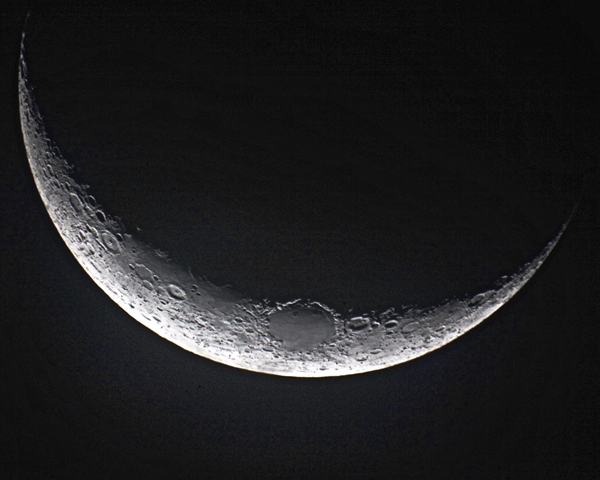WAXING CRESCENT MOON
2015 February 21, 7:38 p.m. EST (Feb. 22, 00:38 UT)
Rosemary Hill Observatory • Bronson • Florida
« RETURN TO THE MAIN RHO PICTURE PAGE »
RETURN TO MOON CATEGORIES
RETURN TO PICTURE CATEGORIES
Images © 2004–2015 H.L. Cohen
Email Cohen followed by @astro.ufl.edu
Last updated 2015 May 18
2015 February 21, 7:38 p.m. EST (Feb. 22, 00:38 UT)
Rosemary Hill Observatory • Bronson • Florida
 Photo Details 2015 Feb. 21, 7:38 p.m. EST TeleVue 127 mm, f/5.2 APO Refractor, Foc. Len. 660 mm w/Televue 4x Powermate (Effec. Foc. Len. 2,640 mm) Camera: Canon DSLR EOS 5D II, Exposure 1/20 sec, f/21 (ISO 2500) |
OBSERVATIONAL CHALLENGES People often ask if the flags planted by Apollo astronauts on the lunar surface are visible from earth-bound telescopes. Of course not. But how small an object can you see with your telescope? FYI: From Earth, one arc second corresponds to about one mile on Moon (more precisely, 0.9 mile). Note that astronomical seeing disks of less than one arc sec are very rare.
Craters are usually named for deceased scientists and explorers. Among fans of Star Trek, Jean-Luc Picard (played by Patrick Stewart) is the well-known captain of the Star Ship Enterprise in the series, Star Trek: The Next Generation. No lunar crater, of course, is named for this character but a small, 14-mile wide (23 km) crater bears the name Picard named for Jean-Félix Picard (1620-1682), a French astronomer. This isolated crater, in a large basin, is easily visible, even in small telescopes. It is most easily seen three days after New Moon or two days after Full Moon when this feature is near the lunar terminator. Therefore, Picard is easily visible in this three-day-old moon photo especially in the enlarged image. Can you find Picard? ("Trekkies" need to know!) ANSWER HERE |
« RETURN TO THE MAIN RHO PICTURE PAGE »
RETURN TO MOON CATEGORIES
RETURN TO PICTURE CATEGORIES
Images © 2004–2015 H.L. Cohen
Email Cohen followed by @astro.ufl.edu
Last updated 2015 May 18